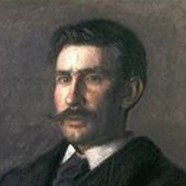N ame of Interviewee: Edward W. Redfield (Dorothy Redfield, his daughter-in-law, and Virginia Lippincott also present)
ame of Interviewee: Edward W. Redfield (Dorothy Redfield, his daughter-in-law, and Virginia Lippincott also present)
Date of birth/age at interview: December 1869/93
Interviewer: Robert H. Lippincott, for Bucks County Realtor Magazine
Interview date: March 4, 1963
Interview location: Redfield home, Centre Bridge
Interview length: 1 hour 30 minutes
Time span discussed: 1870s to 1963
Summary: Edward W. Redfield talks with a very precise memory, charm and humor about his life, his paintings, and their creation process. Included in this interview are stories and comments about many other Bucks county artists, specific locations in and around New Hope, Centre Bridge, the river area, and Philadelphia, and about his work in France. Not to be missed details include a description of the physical work involved in arriving on scene with all equipment needed to paint “in one go” (often 7 hours) during the cold winter months.
Time markers:
00:00:55 – his property, house built prior to 1800
00:02:25 – Henry Mercer, Fonthill, Mercer tiles
00:05:23 – arrived in Bucks County, bought Boldie property May 1898, Paxson’s (Hendrick’s) Island part of estate
00:06:17 – not a member of the art colony
00:06:56 – most artists arrived within 10 years of his arrival; William Lathrop was second; who came first
00:08:27 – his schooling and art study; had drawing exhibited in Centennial Exposition
00:09:58 – reason for year in France; upon return heard Lathrop had moved to area; Dr. George Marshall
00:11:28 – there were earlier artists in Delaware Valley, George Innis, Carl Weber
00:12:26 – post office system, five deliveries a day in Centre Bridge
00:12:57 – describes in detail his “in one go” painting process, outside about seven hours
00:14:25 – Garber’s and Lathrop’s styles of painting
00:16:16 – winter blue color of his snow; art cannot be taught, need love for it; leave something for the imagination
00:17:31 – Stieglitz’s photography, altered his plates for effect
00:18:09 – mainly landscape painter; some portraiture; stories about two portraits he painted
00:24:20 – equipment and process to paint for seven hours; when no automobiles, only travel about one mile; later Pt. Pleasant, New Hope, Lambertville, Frenchtown, Delaware Water Gap, Lake Wallenpaupack
00:29:50 – why Bucks County; Depression
00:31:20 – arranging subjects in his composition, light
00:32:10 – Walter Schofield, their “similar” work
00:36:22 – love of nature, effect of light
00:37:42 – burned 700 paintings of the 1,200 he possessed, must meet standards
00:38:01 – his property and adjacent properties
00:40:10 – titling his works, painting not to make money; where sold paintings
00:42:52 – not a socializer, views on socializing
00:43:42 – views on the changes in New Hope
00:44:45 – Ingham Springs, water
00:45:40 – painting around Neely Mill and Thompson house; old copper mine near Neely Mill
00:47:22 – New Hope not improved, river view blocked; Parry House and mill in New Hope
00:48:22 – keeping warm in winter while painting outside
00:50:38 – Carversville mill painted in the cold and rain; now in a museum (also in recording 2, slightly different)
00:54:35 – painted scenes never repeated exactly; done in different perspective
00:56:00 – gardening and the paintings of spring blossoms; used entire palette
00:57:30 – did not want to work with art dealers; wanted to do what he wanted
00:58:58 – incidents that stood out; painting a cow on Hendrick’s island
01:03:17 – Lippincott story
01:04:45 – Paris and Beaux Arts student competition; history examination story
01:07:45 – Bucks County best place to live; bridges and mills, Lumberton and Cuttaloosa
01:10:50 – early life in Philadelphia; markets
01:13:27 – revival meeting
01:15:50 – total number of paintings; his first sale; blue shadows on snow
01:18:55 – snow paintings in Europe; artists who influenced his work
01:24:36 – George Sotter and his work; Carl Weber and his work
01:27:14 – his artist friends normal people, would not take them for artists
01:29:00 – recording fades as group leaves room to see paintings
